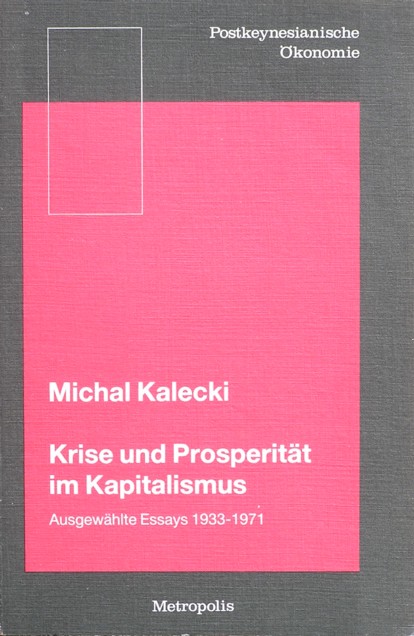

Everybody who is interested in general political policies must have some knowledge about the budget policy of the state with regard to the conjuncture. The economic theory behind the budget policy is commonly attributed to the English economist J.M. Keynes, but strictly speaking this is not completely right. For, the Polish economist M. Kalecki has published almost the same theory in 1933, and that is three years before Keynes published his ideas1. Here it must be added, that Kalecki formulates his theory in a more understandable manner than Keynes, and also more complete. Therefore the work of Kalecki has remained popular with some economists, even in Cambridge, the home port of Keynes. For instance, the well-known economist Joan Robinson prefers the formulas of Kalecki in her books.
In 1954 the theory of Kalecki appeared as a textbook, with the title Theory of economic dynamics. More than thirty years later the quality publisher Metropolis-Verlag has published the German volume Krise und Prosperität im Kapitalismus by Kalecki, which contains most parts of the mentioned English textbook. The volume is definitely worthwhile. First the measures are explained, which allow the state to more or less stabilize the domestic effective demand, so that it can curb the economic conjuncture. In later articles Kalecki elaborates on his formulas, and develops a complete theory of the conjuncture, which explains the fluctuations of the national income, including the crisis. In 1955, after a long stay abroad, Kalecki returns to Poland, and contributes to the establishment of the Leninist state. The volume also contains some articles from this latter period.
The texts of Kalecki regularly contain critical remarks about the industry, for instance regarding the formation of monopolies, which at the time was a topical theme. He hopes that the trade union movement develops into a countervailing power2. Although he is not a marxist, yet the theory of Marx has inspired him. Kalecki certainly was not an adherent of Lenin, and therefore his final years in Poland have not been very happy. He hardly had any influence. Incidentally, Kazimierz Laski, who writes the preface of the volume, also has collaborated with the regime for some time, motivated by ideals. In the end Laski become so disillusioned, that he definitely left Poland. Then he is already an expert of the work of Kalecki, and that becomes clear in the summary, that he gives in his preface of the book.
The first part of the volume contains the early articles of Kalecki about economic dynamics. Here the mentioned famous study of 1933 can be found. Then Kalecki already displays his insights in the conjuncture, and points to the consequences of delays in the investment process. The prosperity can be furthered simply by making extra investments. The entrepreneurs receive the investments as profits. Still in the same year he adds the consequences of the foreign trade to his model, as well as the state investments (which he calls the domestic-export). In 1935 Kalecki studies the beneficial effect of investments on the employment. As long as the spending power is maintained, the national income will increase due to the effect of the multiplier. Moreover, Kalecki studies the effect of the extra investments on the balance of payments, as far as this requires extra import.
It is interesting to see that Kalecki divides the economy in three branches, following Marx. In his argument about the development of the real wages he assumes, that the industry is an oligopoly, and therefore the product prices are rather rigid. Furthermore, he studies the various types of taxes, and propagates the tax on capital. However, he fears that this infringement on capital (the K-word!) is politically unfeasable. The capitalists will protest3. And Kalecki develops his own price theory, which is difficult to judge for your reviewer. Then in 1943 Kalecki presents his theory of business cycles with well formulated investment functions. This part is rather mathematical, but this has the advantage that the effects of the consumption and of the profit on the economic fluctuations become clearly visible.
Then in 1944 Kalecki presents proposals for realizing full employment. There are three options: deficit spending, stimulating the private investments, and redistribution of incomes. However, Kalecki doubts that the industry will be willing to cooperate in combatting the unemployment4. This is a discussion about the practical economic policy and about politics, and a proof of the wide knowledge of Kalecki. Finally, from 1936 there is an interesting reaction of Kalecki on the theory of Keynes. The Polish articles of Kalecki (after 1955) do not have the huge importance of his previous work. Then he specializes in elaborations on the marxist theory, which at that moment has already become a dogma. They are not of economic eminence. The importance of these texts is mainly in the influence, that they exert on the then Polish regime.
In conclusion, Krise und Prosperität im Kapitalismus is a fascinating book. However, the arguments of Kalecki are always so concise and far-reaching, that five years ago your reviewer regularly doubted whether he truly understood everything. Strictly speaking it is necessary to read the material several times, and to compare it with supplementary sources. Incidentally, it seems that the same holds for the publications of Keynes. Your reviewer happily lets the reader decide, whether this intellectual challenge is worth the effort.